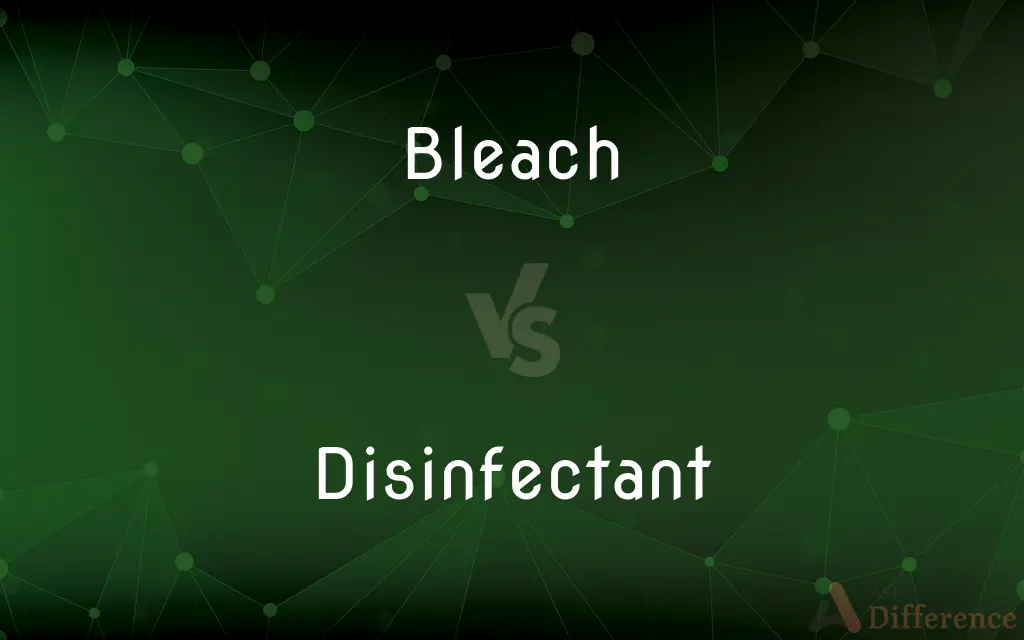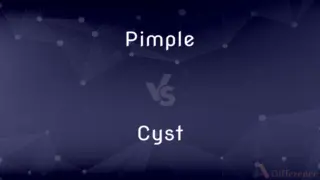Bleach vs. Disinfectant — What's the Difference?
By Maham Liaqat & Fiza Rafique — Updated on March 30, 2024
Bleach is a chemical that removes colors or whitens, often used for cleaning and disinfecting, while disinfectants are agents designed to inhibit the growth of harmful microorganisms on surfaces.

Difference Between Bleach and Disinfectant
Table of Contents
ADVERTISEMENT
Key Differences
Bleach, specifically chlorine bleach, is widely used for its strong whitening and disinfecting properties. It works by breaking down the chemical bonds that give dyes their color, which also disrupts the structure of bacteria and viruses. Whereas disinfectants, which can include a variety of chemicals including but not limited to bleach, are formulated primarily to eliminate or reduce the presence of pathogenic microorganisms.
Disinfectants are chosen based on the type of microorganism they are effective against, such as bacteria, viruses, fungi, or spores. Bleach is a broad-spectrum disinfectant effective against many pathogens but can be corrosive and may damage some surfaces. On the other hand, other disinfectants may be designed to be less corrosive and can be used on a wider range of materials but may have a narrower spectrum of activity.
The active ingredient in bleach, sodium hypochlorite, is potent and offers the dual function of whitening and disinfecting. Disinfectants may contain various active ingredients like alcohols, quaternary ammonium compounds, hydrogen peroxide, and others, each with specific uses, advantages, and limitations.
Using bleach in high concentrations or without proper ventilation can lead to respiratory irritation or other health risks. Disinfectants, while also potentially hazardous, often come with instructions for safe use to minimize risks, emphasizing the importance of following manufacturer guidelines for both types of products.
For certain applications, such as disinfecting surfaces that come into contact with food, non-bleach disinfectants may be preferred to avoid the risks of contamination. Bleach must be diluted correctly for safe and effective use, demonstrating the need for careful handling when choosing it as a disinfectant.
ADVERTISEMENT
Comparison Chart
Active Ingredient
Sodium hypochlorite.
Varied (alcohols, quats, hydrogen peroxide, etc.)
Spectrum of Activity
Broad-spectrum against pathogens.
Can be broad or narrow, depending on the type.
Potential Hazards
Corrosive, can damage surfaces, respiratory irritation.
Varies, some may be less corrosive, but still require safe handling.
Use in Food Contact Surfaces
Requires careful dilution and rinsing.
Some designed specifically for safe use on food-contact surfaces.
Compare with Definitions
Bleach
A strong chemical used for whitening and disinfecting.
She used bleach to ensure the bathroom was free of mold.
Disinfectant
Often used to prevent the spread of infections.
Regularly disinfecting high-touch surfaces helps prevent colds.
Bleach
An agent that removes color or stains.
Bleach is effective in removing wine stains from fabric.
Disinfectant
Some are designed for specific surfaces or materials.
There are disinfectants specifically for use on wood and upholstery.
Bleach
May cause irritation if not used properly.
Always use bleach in a well-ventilated area to avoid inhaling fumes.
Disinfectant
Can include various chemical compositions.
Alcohol-based disinfectants are commonly used in hand sanitizers.
Bleach
Sodium hypochlorite solution commonly used in households.
Adding bleach to the laundry makes whites whiter.
Disinfectant
May require specific contact time to be effective.
The disinfectant must remain on the surface for at least 10 minutes.
Bleach
Bleach is the generic name for any chemical product that is used industrially and domestically to remove color from a fabric or fiber or to clean or to remove stains in a process called bleaching. It often refers, specifically, to a dilute solution of sodium hypochlorite, also called "liquid bleach".
Disinfectant
A chemical liquid that destroys bacteria
All surfaces are cleaned manually or by pressure washer with disinfectant
A cat won't use its litter box if it's cleaned with smelly disinfectants
Bleach
To remove the color from, as by means of chemical agents or sunlight
Over time, the exposure to sunlight bleached the rug in front of the window.
Disinfectant
Causing disinfection
Cleansing and disinfectant products
Bleach
To make white or colorless
Dawn bleached the mountains.
Disinfectant
An agent, such as heat, radiation, or a chemical, that is applied to inanimate objects to destroy, neutralize, or inhibit the growth of disease-carrying microorganisms.
Bleach
To whiten by causing the death or expulsion of algal symbionts from (coral).
Disinfectant
Serving to disinfect.
Bleach
To act as or use a bleach.
Disinfectant
An agent (as heat or radiation or a chemical) that destroys microorganisms that might carry disease
Bleach
To become white as a result of the loss of algal symbionts, usually following an environmental stress such as increased water temperature. Used of coral.
Disinfectant
Preventing infection by inhibiting the growth or action of microorganisms
Bleach
A chemical agent used for bleaching.
Bleach
The act of bleaching.
Bleach
The degree of bleaching obtained.
Bleach
(archaic) Pale; bleak.
Bleach
(transitive) To treat with bleach, especially so as to whiten (fabric, paper, etc.) or lighten (hair).
Bleach
(intransitive) To be whitened or lightened (by the sun, for example).
Bleach
To lose color due to stress-induced expulsion of symbiotic unicellular algae.
Once coral bleaching begins, corals tend to continue to bleach even if the stressor is removed.
Bleach
To make meaningless; to divest of meaning; to make empty.
Semantically bleached words that have become illocutionary particles
Bleach
(uncountable) A chemical, such as sodium hypochlorite or hydrogen peroxide, or a preparation of such a chemical, used for disinfecting or whitening.
Bleach
(countable) A variety of bleach.
Bleach
An act of bleaching; exposure to the sun.
Bleach
A disease of the skin.
Bleach
To make white, or whiter; to remove the color, or stains, from; to blanch; to whiten.
The destruction of the coloring matters attached to the bodies to be bleached is effected either by the action of the air and light, of chlorine, or of sulphurous acid.
Immortal liberty, whose look sublimeHath bleached the tyrant's cheek in every varying clime.
Bleach
To grow white or lose color; to whiten.
Bleach
The whiteness that results from removing the color from something;
A complete bleach usually requires several applications
Bleach
An agent that makes things white or colorless
Bleach
The act of whitening something by bleaching it (exposing it to sunlight or using a chemical bleaching agent)
Bleach
Remove color from;
The sun bleached the red shirt
Bleach
Make whiter or lighter;
Bleach the laundry
Common Curiosities
Can bleach be used as a disinfectant?
Yes, when properly diluted, bleach is an effective broad-spectrum disinfectant.
Are all disinfectants bleach-based?
No, disinfectants can contain a variety of active ingredients, not just sodium hypochlorite (bleach).
Can I use any disinfectant on all surfaces?
No, some disinfectants may damage certain materials. It's important to choose a disinfectant suitable for the surface you're treating.
Why is ventilation important when using bleach?
Bleach can release fumes that irritate the respiratory system, so adequate ventilation is necessary to avoid inhaling these fumes.
Is bleach more effective than other disinfectants?
Bleach is broadly effective against many pathogens, but its suitability depends on the specific application and material safety considerations.
Are there disinfectants safe for food contact surfaces?
Yes, certain disinfectants are designed to be safe for use on food contact surfaces, often requiring no rinse after application.
How do I properly dilute bleach for disinfection?
Follow the manufacturer's instructions for dilution ratios, as using too much or too little can affect effectiveness and safety.
Is it safe to mix bleach with other cleaning agents?
No, mixing bleach with ammonia or other cleaning agents can release dangerous gases.
Can using disinfectants create resistant bacteria or viruses?
Overuse or improper use of disinfectants can contribute to the development of resistance in some microorganisms.
How often should I use disinfectants in my home?
Frequency depends on the area and usage but focus on high-touch surfaces and during illness outbreaks.
Do I need to rinse surfaces after disinfecting with bleach?
For surfaces that come into contact with food or areas accessible to children and pets, rinsing with water after disinfecting with bleach is recommended.
What should I do if I accidentally ingest a disinfectant or bleach?
Seek medical attention immediately and follow the emergency instructions on the product label.
How long does the disinfecting effect of bleach last on surfaces?
The disinfecting effect lasts until the surface is contaminated again or the bleach solution evaporates.
Share Your Discovery

Previous Comparison
Pimple vs. Cyst
Next Comparison
Kittiwake vs. SeagullAuthor Spotlight
Written by
Maham LiaqatCo-written by
Fiza RafiqueFiza Rafique is a skilled content writer at AskDifference.com, where she meticulously refines and enhances written pieces. Drawing from her vast editorial expertise, Fiza ensures clarity, accuracy, and precision in every article. Passionate about language, she continually seeks to elevate the quality of content for readers worldwide.
















































